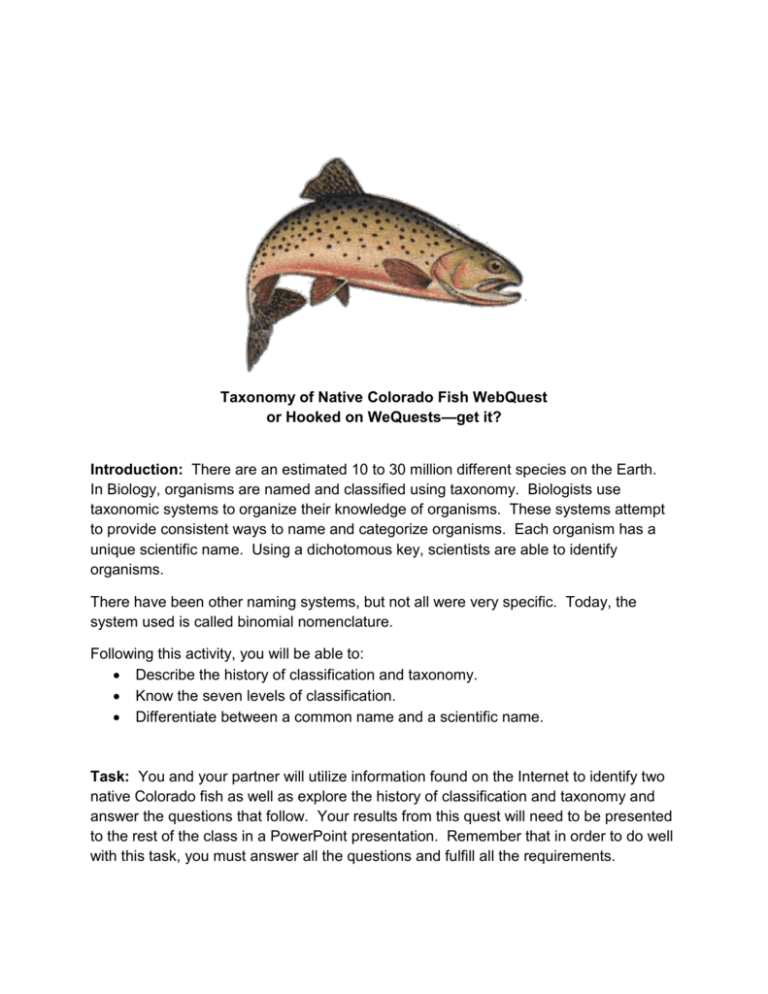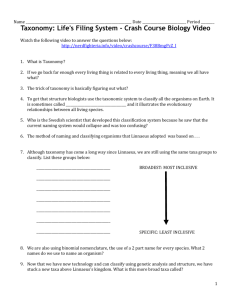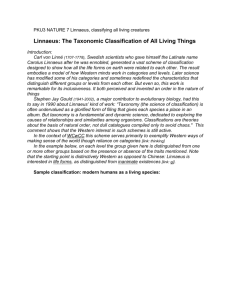Felis leo
advertisement

Taxonomy of Native Colorado Fish WebQuest or Hooked on WeQuests—get it? Introduction: There are an estimated 10 to 30 million different species on the Earth. In Biology, organisms are named and classified using taxonomy. Biologists use taxonomic systems to organize their knowledge of organisms. These systems attempt to provide consistent ways to name and categorize organisms. Each organism has a unique scientific name. Using a dichotomous key, scientists are able to identify organisms. There have been other naming systems, but not all were very specific. Today, the system used is called binomial nomenclature. Following this activity, you will be able to: Describe the history of classification and taxonomy. Know the seven levels of classification. Differentiate between a common name and a scientific name. Task: You and your partner will utilize information found on the Internet to identify two native Colorado fish as well as explore the history of classification and taxonomy and answer the questions that follow. Your results from this quest will need to be presented to the rest of the class in a PowerPoint presentation. Remember that in order to do well with this task, you must answer all the questions and fulfill all the requirements. Process: Part A: The History of Classification and Taxonomy 1. Using the Linnaeus link, answer the following questions: Linnaeus did not go to college to become a taxonomist. What was he actually studying? How did this lead him to his work in classification and taxonomy? Although Linnaeus gets credit for laying the foundation for taxonomy and classification, he could not have been successful without the help of his students and peers. How does this demonstrate the nature of scientific discovery? What was the title of the Linnaeus book on classification? Linnaeus focused on the classification of plants. What characteristic(s) did Linnaeus use to classify plants? How does this compare to the characteristics that are used today? Compare and contrast the classification system used by Linnaeus to the classification system used by Linnaeus to the classification system that we use now. Describe at least two problems that resulted from the naming system used prior to Linnaeus. What do we mean by the term binomial nomenclature? Name at least one way this is used outside of the field of taxonomy. Linnaeus’s work was published before Darwin developed his theory of natural selection. How do you think Linnaeus may have contributed to Darwin’s idea that species change over time due to pressure within their environment? Explain. Part B: Fish Taxonomy 1. Out of the following list of fish native to Colorado, pick two. You may not pick one that another group has already signed up for. The rule is; first come, first served. Common names of native Colorado fish: Colorado Pikeminnow Humpback chub Razorback sucker Bonytail Mottled Sculpin Speckled Dace Fathead Minnow Black Bullhead Common Shiner Orangespotted Sunfish Longnose Sucker Creek Chub Roundtail Chub Bluehead Sucker Mountain Whitefish Flannelmouth Sucker Rio Grand Sucker River Carpsucker Arkansas Darter Black Bullhead Plains Killifish Red Shiner Redbelly Dace White Sucker Orangethroat Darter Green Sunfish Cutthroat Trout Johnny Darter Channel Catfish 2. Using the resources listed or your own, answer the following questions/create the following slides: On two separate slides, insert a picture of both your fish and include both its common name and just for the “halibut”, add the species name. Get it? Show your fish’s taxonomy starting with its Kingdom and ending with species. Consider the following genus and species: Felis concolor and Felis leo. First identify them on a slide with both their common and genus species names. Include a picture for each. Answer the following questions. Why is Latin used in binomial nomenclature? What taxa always ends in ae? Of the two, genus and species, which one is often abbreviated and why? Show the taxa of a human being. Conclusion: Now that you’re fin-ished (get it?) Here’s a rubric to use as a checklist before you present your project: Grading “Scales” get it? Assignment 8 Slides to answer History of Classification and Taxonomy 2 slides with fish pictures Fish taxonomies (2) Felis concolor vs. Felis leo Why is Latin used in binomial nomenclature What taxa always ends in ae Abbreviation explanation Human being taxa Total points possible Points Possible 40 20 10 10 10 5 5 7 107 Check when done Resources: Linnaeus: http://www.ucmp.berkeley.edu/history/linnaeus.html How to make a dichotomous key: http://nerds.unl.edu/Pages/preser/sec/skills/dkeys.html Fish classification: http://www.spart5.k12.sc.us/techtraining/teacher/webpages/SCFish/fish_classifica tion.htm Animal Classification: http://anthro.palomar.edu/animal/ To find information on your fish’s taxonomy, google your fish’s name and taxonomy. You may have to “fish”around a bit to find it, but trust us, it’s out there somewhere. I lobster but then I flounder. She’s a beauty!








